Abstract
A management plan for stab wounds to the anterior abdomen incorporating local wound exploration and quantitative peritoneal lavage was applied to 572 patients. One hundred eighty-five of these patients presented with shock, peritonitis, or evisceration and underwent immediate exploratory laparotomy with the finding of an intraperitoneal organ injury in 183 (99%). The remaining 387 patients with a negative physical examination underwent exploration of the stab wound to determine fascial penetration. Wound exploration was negative in 151 of these patients and they were discharged from the emergency room. Two hundred thirty-six additional patients had penetration of the fascia and underwent peritoneal lavage. Ninety-two per cent of patients with lavage counts greater than 50,000 had an intraperitoneal organ injury. No patients with lavage counts less than 1,000 red cells had an organ injury. Forty-three per cent of patients in the intermediate group (1,000-50,000 RBCs/mm3) had an organ injury and 59% included penetration of a hollow viscus. An approach incorporating local wound exploration and quantitative peritoneal lavage followed by exploratory laparotomy for red blood cell counts greater than 1,000 should result in less than 10% negative laparotomies and no missed injuries.
Full text
PDF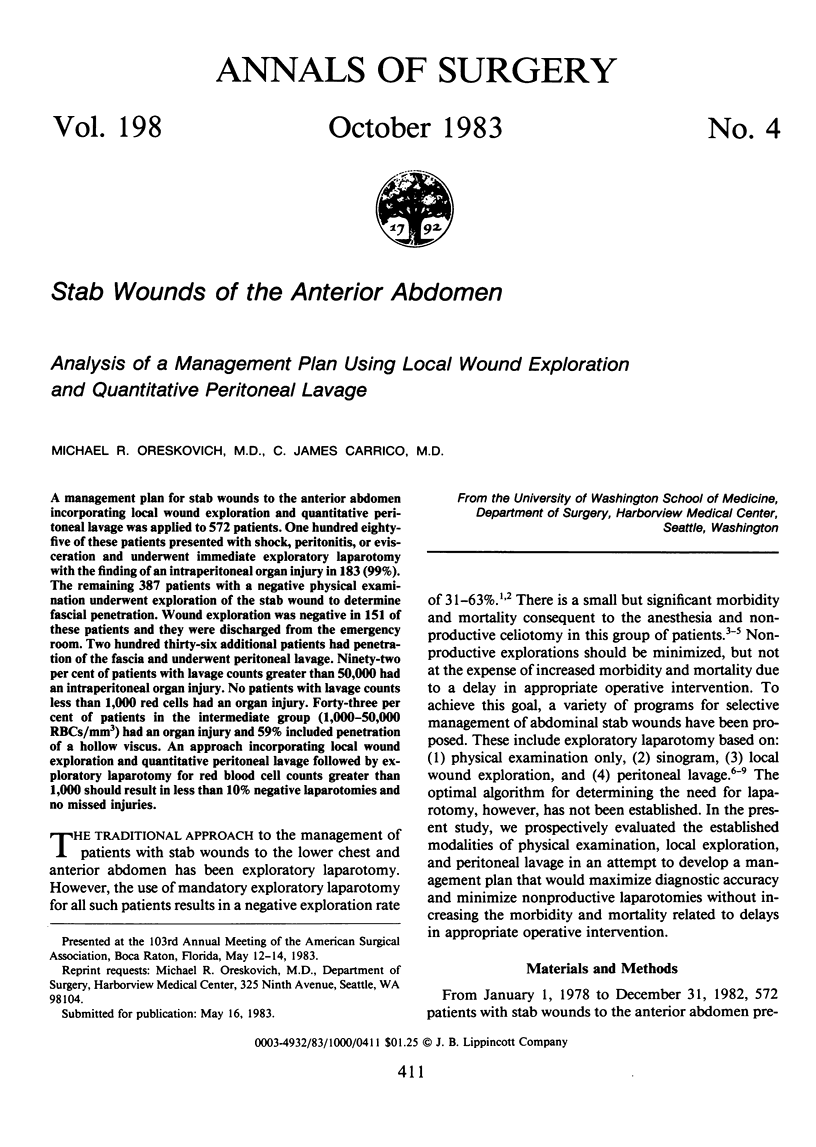
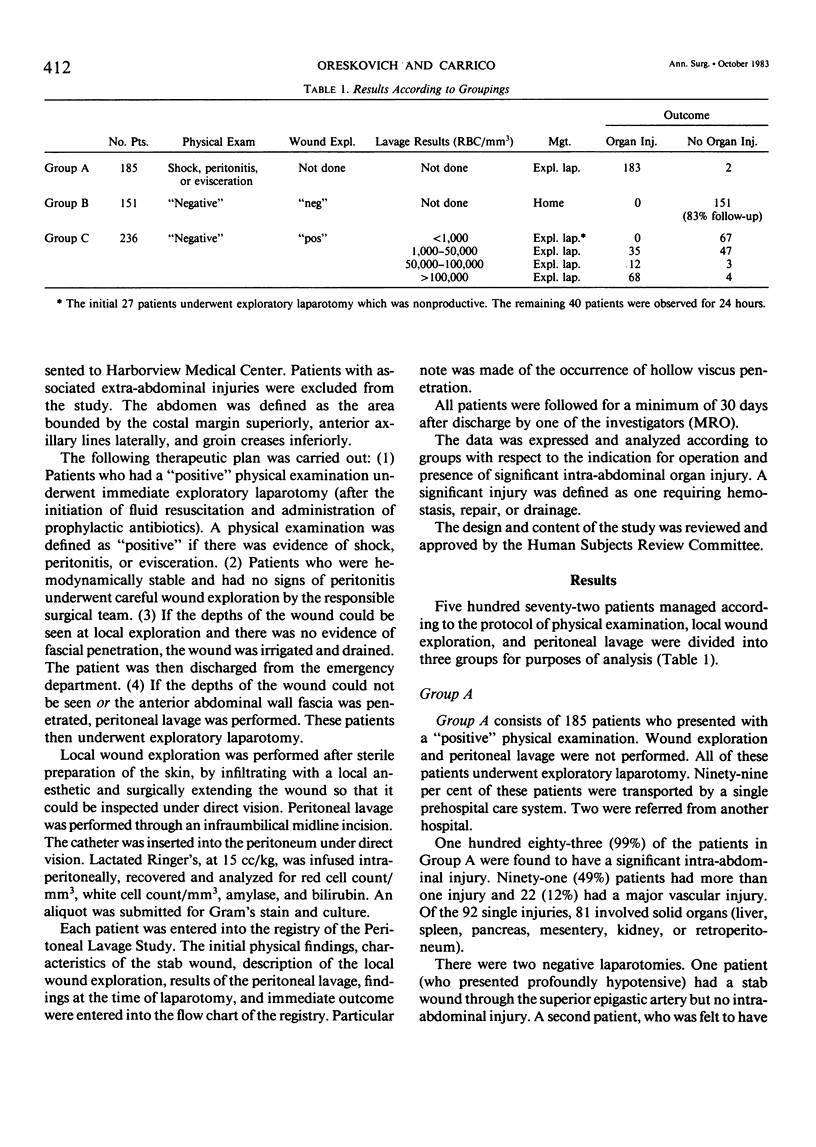
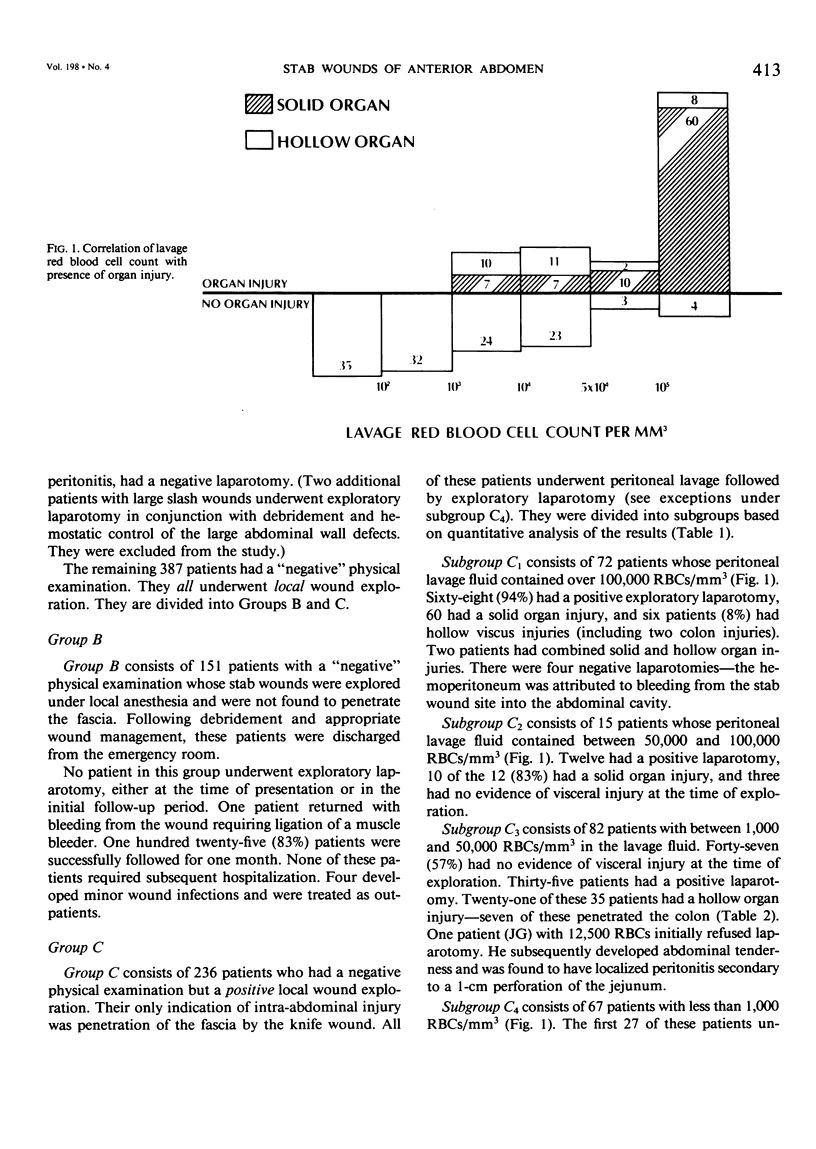
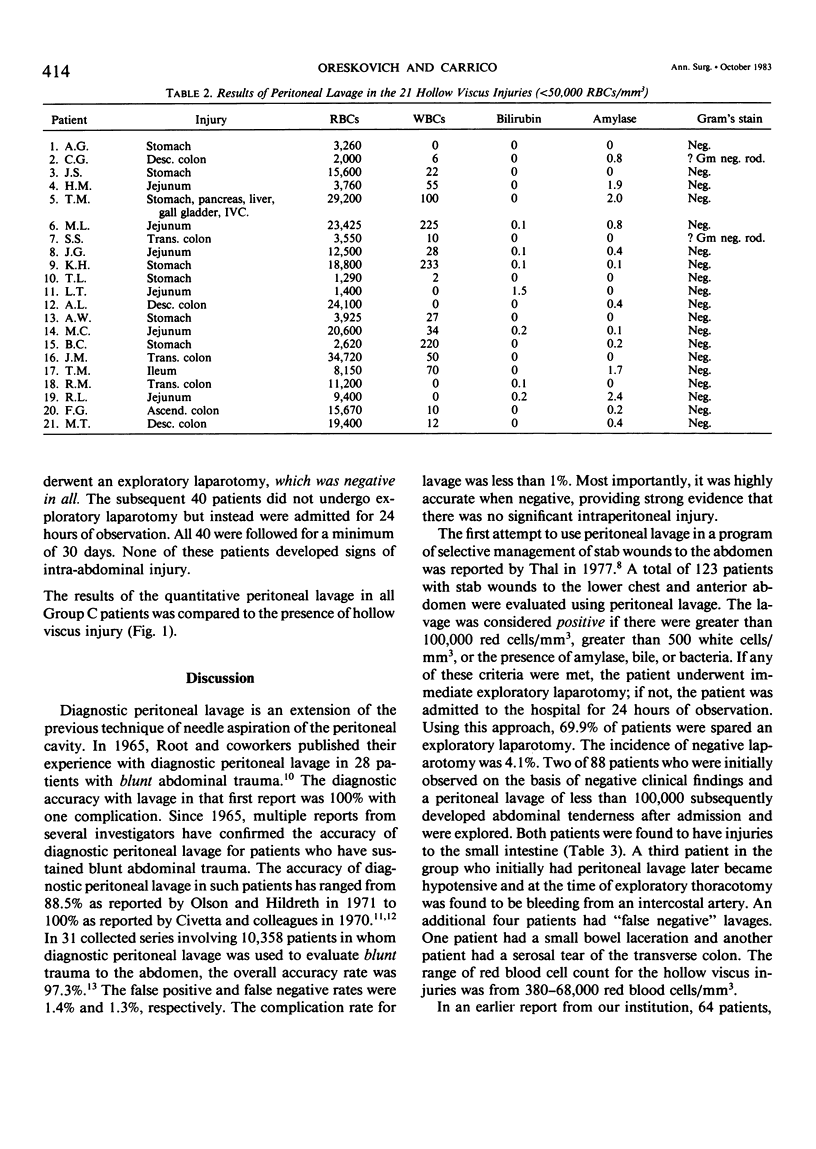
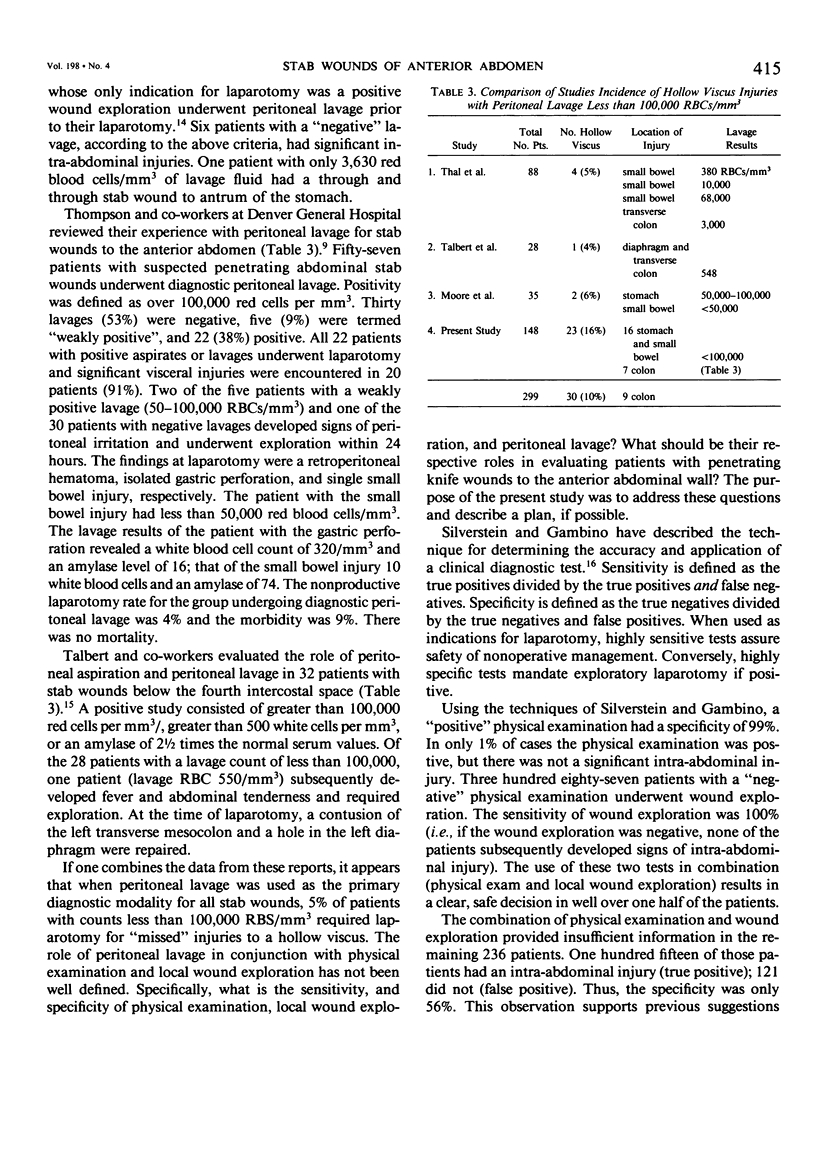
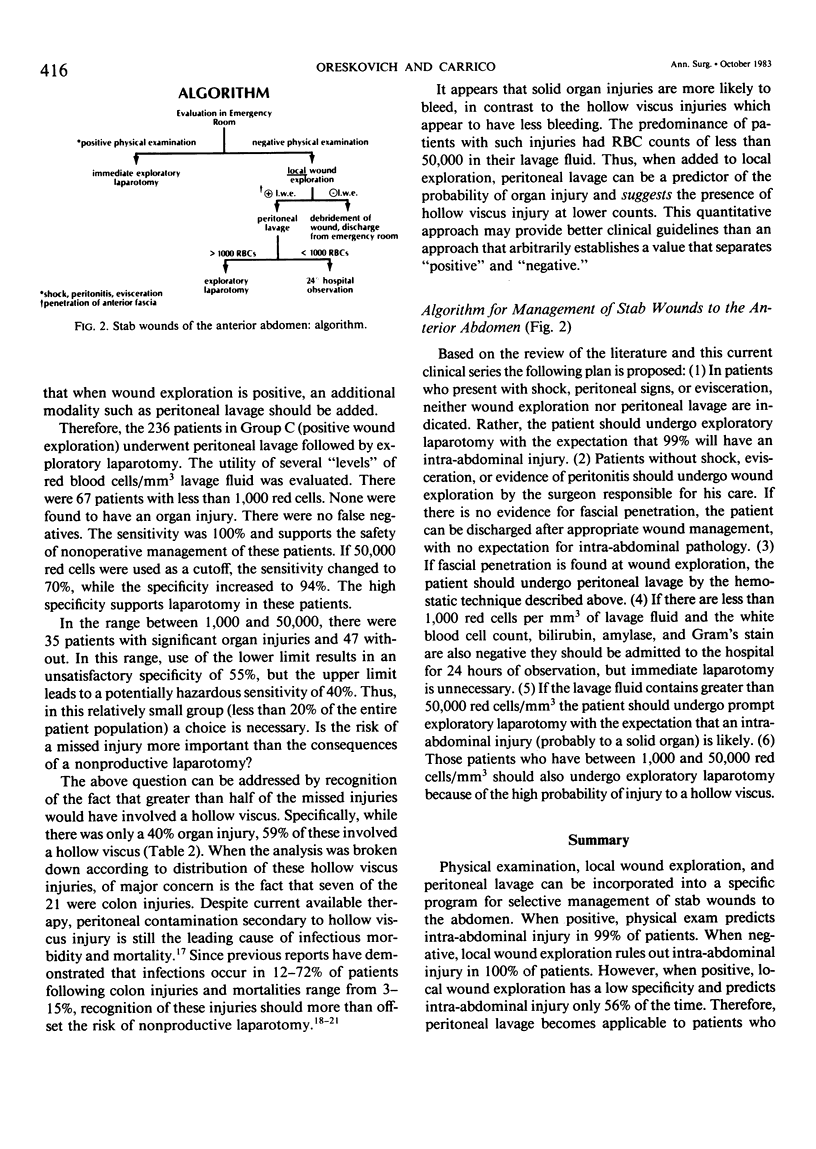
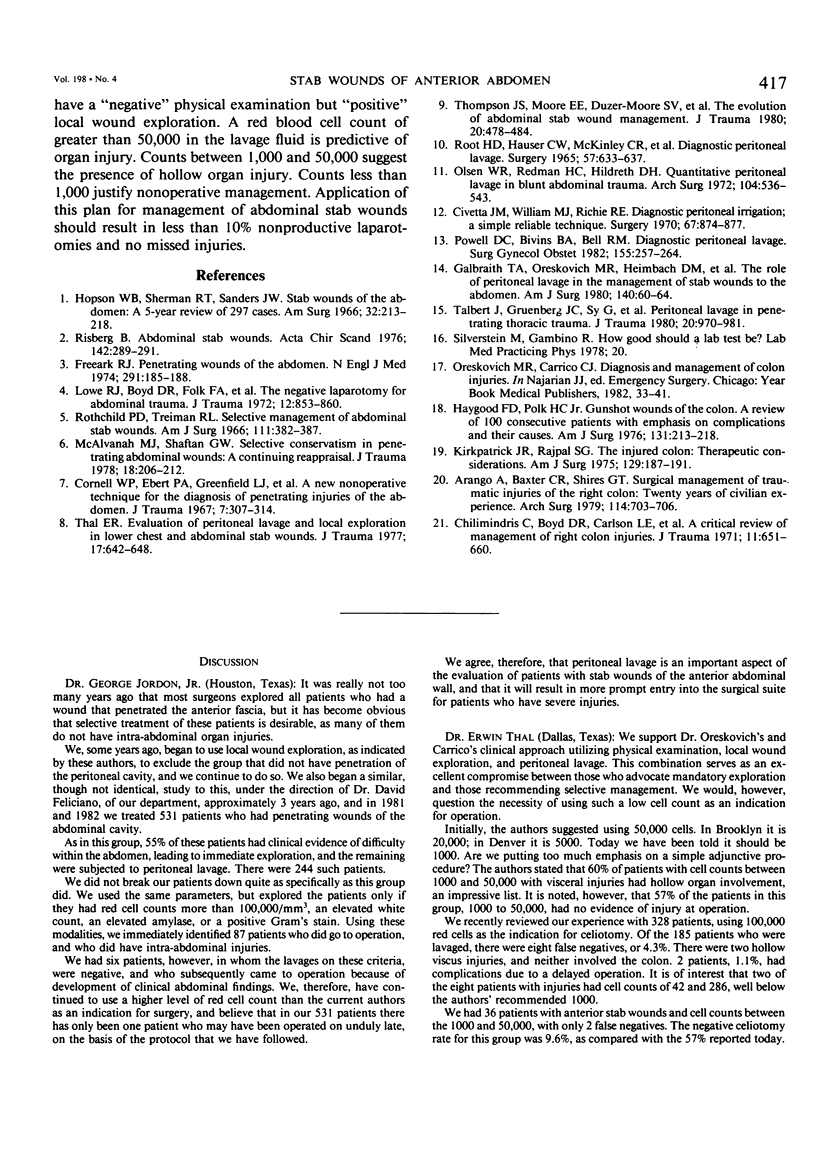
Selected References
These references are in PubMed. This may not be the complete list of references from this article.
- Arango A., Baxter C. R., Shires G. T. Surgical management of traumatic injuries of the right colon. Twenty years of civilian experience. Arch Surg. 1979 Jun;114(6):703–706. doi: 10.1001/archsurg.1979.01370300057008. [DOI] [PubMed] [Google Scholar]
- Chilimindris C., Boyd D. R., Carlson L. E., Folk F. A., Baker R. J., Freeark R. J. A critical review of management of right colon injuries. J Trauma. 1971 Aug;11(8):651–660. doi: 10.1097/00005373-197108000-00002. [DOI] [PubMed] [Google Scholar]
- Civetta J. M., Williams M. J., Richie R. E. Diagnostic peritoneal irrigation--a simple and reliable technique. Surgery. 1970 May;67(5):874–877. [PubMed] [Google Scholar]
- Cornell W. P., Ebert P. A., Greenfield L. J., Zuidema G. D. A new nonoperative technique for the diagnosis of penetrating injuries to the abdomen. J Trauma. 1967 Mar;7(2):307–314. doi: 10.1097/00005373-196703000-00013. [DOI] [PubMed] [Google Scholar]
- Freeark R. J. Penetrating wounds of the abdomen. N Engl J Med. 1974 Jul 25;291(4):185–188. doi: 10.1056/NEJM197407252910406. [DOI] [PubMed] [Google Scholar]
- Galbraith T. A., Oreskovich M. R., Heimbach D. M., Herman C. M., Carrico C. J. The role of peritoneal lavage in the management of stab wounds to the abdomen. Am J Surg. 1980 Jul;140(1):60–64. doi: 10.1016/0002-9610(80)90418-3. [DOI] [PubMed] [Google Scholar]
- Haygood F. D., Polk H. C., Jr Gunshot wounds of the colon. A review of 100 consecutive patients, with emphasis on complications and their causes. Am J Surg. 1976 Feb;131(2):213–218. doi: 10.1016/0002-9610(76)90100-8. [DOI] [PubMed] [Google Scholar]
- Hopson W. B., Sherman R. T., Sanders J. W. Stab wounds of the abdomen: 5-year review of 297 cases. Am Surg. 1966 Mar;32(3):213–218. [PubMed] [Google Scholar]
- Kirkpatrick J. R., Rajpal S. G. The injured colon: therapeutic considerations. Am J Surg. 1975 Feb;129(2):187–191. doi: 10.1016/0002-9610(75)90296-2. [DOI] [PubMed] [Google Scholar]
- Lowe R. J., Boyd D. R., Folk F. A., Baker R. J. The negative laparotomy for abdominal trauma. J Trauma. 1972 Oct;12(10):853–861. doi: 10.1097/00005373-197210000-00004. [DOI] [PubMed] [Google Scholar]
- McAlvanah M. J., Shaftan G. W. Selective conservatism in penetrating abdominal wounds: a continuing reappraisal. J Trauma. 1978 Mar;18(3):206–212. doi: 10.1097/00005373-197803000-00010. [DOI] [PubMed] [Google Scholar]
- Olsen W. R., Redman H. C., Hildreth D. H. Quantitative peritoneal lavage in blunt abdominal trauma. Arch Surg. 1972 Apr;104(4):536–543. doi: 10.1001/archsurg.1972.04180040150026. [DOI] [PubMed] [Google Scholar]
- Powell D. C., Bivins B. A., Bell R. M. Diagnostic peritoneal lavage. Surg Gynecol Obstet. 1982 Aug;155(2):257–264. [PubMed] [Google Scholar]
- ROOT H. D., HAUSER C. W., MCKINLEY C. R., LAFAVE J. W., MENDIOLA R. P., Jr DIAGNOSTIC PERITONEAL LAVAGE. Surgery. 1965 May;57:633–637. [PubMed] [Google Scholar]
- Rothschild P. D., Treiman R. L. Selective management of abdominal stab wounds. Am J Surg. 1966 Mar;111(3):382–387. doi: 10.1016/s0002-9610(66)80016-8. [DOI] [PubMed] [Google Scholar]
- Talbert J., Gruenberg J. C., Sy G., Brown R. S. Peritoneal lavage in penetrating thoracic trauma. J Trauma. 1980 Nov;20(11):979–981. doi: 10.1097/00005373-198011000-00014. [DOI] [PubMed] [Google Scholar]
- Thal E. R. Evaluation of peritoneal lavage and local exploration in lower chest and abdominal stab wounds. J Trauma. 1977 Aug;17(8):642–648. doi: 10.1097/00005373-197708000-00012. [DOI] [PubMed] [Google Scholar]
- Thompson J. S., Moore E. E., Van Duzer-Moore S., Moore J. B., Galloway A. C. The evolution of abdominal stab wound management. J Trauma. 1980 Jun;20(6):478–484. doi: 10.1097/00005373-198006000-00008. [DOI] [PubMed] [Google Scholar]


